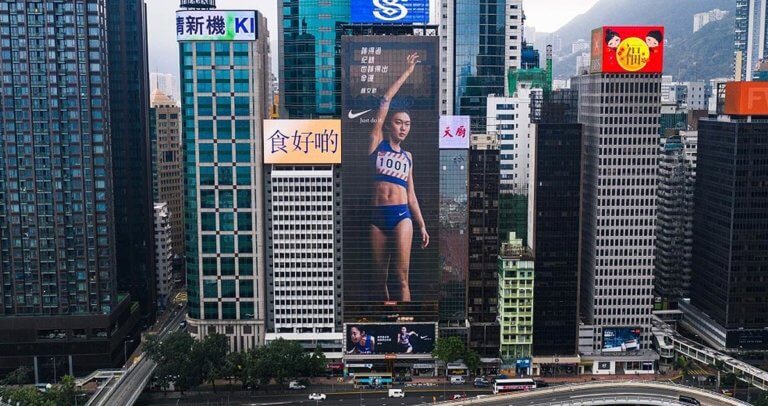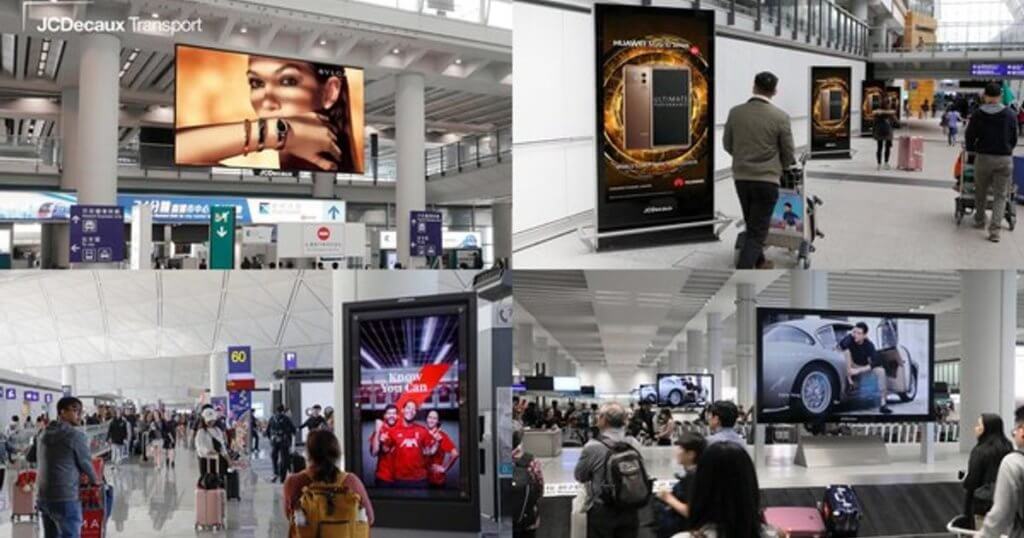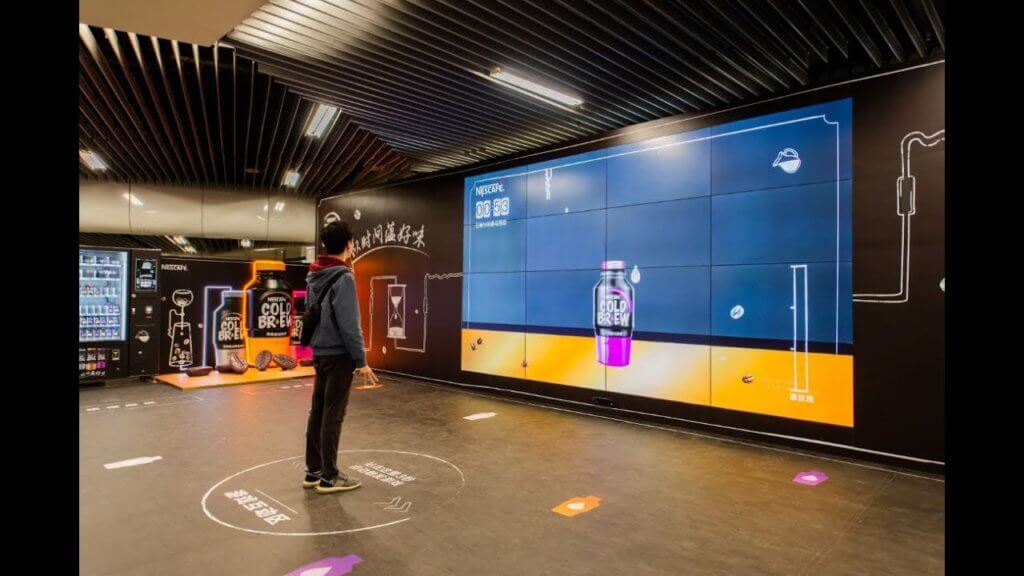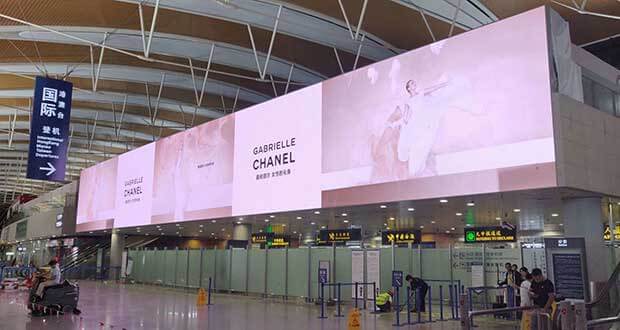
Although it’s no surprise that Out-of-Home (OOH) ad spending in the United States is the highest of any country on earth, according to Statista, ad spending in the OOH advertising segment in China is projected to reach $8.839 million in 2021. China has one of the largest OOH markets in the world and has recently been focusing on Digital OOH (DOOH) now that people are back outside again. According to a recent Campaign article, the OOH market in China is valued at around US$9 billion, with DOOH estimated to be worth 30% of that figure. Those are some huge numbers! The number of active COVID-19 cases in China is now very low, allowing the country to go back to some semblance of normalcy. That also means that OOH advertisers are once again, beginning to think of new and noteworthy ways of targeting consumers as they return to work, to restaurants, to parties, to hotels, and to outdoor physical activities. What’s been taking off recently in the major urban city of Hong Kong in China, is programmatic OOH advertising. According to the State of the Nation report for Hong Kong, a large proportion (84%) of Hong Kong respondents state they have recently bought, planned, or placed OOH programmatically in the last 12 months, above social media. That is huge for OOH, especially considering the influence that social media has taken on over the past few years. OOH advertisers in China are looking to embrace technologically-driven advertising that targets consumers where they’re going to be the most this coming year, outside. In this article we’ll do a deep-dive into the reasons why China, specifically the city of Hong Kong, has taken a liking to DOOH and programmatic advertising recently, and what it means for the OOH industry.

DOOH advertising is going through some significant changes in the Asian Pacific region. According to an article written in The Drum recently, DOOH spending is expected to grow over 18% each year until 2026. This growth has come about due to developed infrastructure in big cities with dense populations, like Hong Kong, which allows for a dense distribution of digital screens. This growth also comes from the ability to now connect different technologically-driven ad mediums into one all-encompassing advertising campaign. Digital screens mixed with website advertising, social media hashtags, and QR codes, can all be integrated to target consumers across multiple channels all at once. This is huge for advertisers who are looking to reach as many people as they can, all at once, on different platforms. It also comes at the perfect time – when people are going to be outside more than ever and therefore, are going to be more willing to pay attention to a DOOH screen.
Flexibility

Advertisers need to be flexible in an ever-changing environment like the one we live in now. If COVID-19 has taught us anything, it’s that our whole world can be flipped upside down in the blink of an eye and that our environments can and will constantly change. Although advertisers are used to the changes in consumer behaviour, trends in the market, and new overall branding strategies, no one could have anticipated the changes that the advertising market has faced over the past year and a half. OOH advertisers have had to completely rearrange their tactics since COVID-19 hit and are coming out the other end with fresh outlooks on the entire medium as a whole. One of the major changes to the medium that Chinese OOH advertisers are stoked on right now is the ability of DOOH and programmatic advertising to be extremely flexible. Being able to switch ads at the drop of a hat depending on the time of day, the weather, and other such changes, makes it easier foron advertisers to target who they want, when they want to. Maximizing ad performance is critical for advertisers, and so by being able to change or adjust ads whenever they need to, it’s cost-effective and smart.
Pricing
Programmatic advertising is extremely cost-effective, let’s break it down. Programmatic is typically traded on a CPM basis, meaning the cost per 1,000 ad impressions. Obviously, depending on the quality of the list and the range of the target audience, the pricing differs. Prices can also vary depending on the industry, the device, the format, and the placement. However, on average, programmatic CPMs range from roughly $0.50 to $2.00 CPM. This is a huge step-up from human-driven trading, which can normally cost up to $10 or more! Not to mention the fact that the whole programmatic process is much easier for OOH advertisers, who only have to click through a website in order to get their advertisement up and running. Therefore, these advertisers can spend more of their precious time working on the creative and idea-based side of the ads they want to push rather than the nuances of getting their advertisements seen. It really is a win-win and it’s why Chinese OOH advertisers are taking notice right now.
Accurate Targeting
In dense urban spaces like Hong Kong, being able to accurately target consumers is immensely beneficial. There are DOOH signs, billboards, posters, and general advertisements as far as the eye can see in a dense space like downtown Hong Kong. That’s why it’s so crucial to be able to target consumers right before they enter a store or even think about what they want to buy. Being able to stick out from the crowd while simultaneously telling consumers what they need in that exact moment is huge for any brand or business. Real-time optimization through DOOH signage is taking over China. According to The Drum, for performance-led campaigns in Hong Kong, 76% of agencies and 38% of advertisers believe that DOOH is important. It’s one thing to be able to lead consumers where you want them based on your ad, it’s a whole other thing to tell consumers how and what they’re feeling before they themselves even know it. This is what’s driving Chinese OOH advertisers and why DOOH is becoming so popular in China.

A couple of years back, the coffee brand Nescafe, wanted to promote their new cold brew coffee using DOOH advertising. Nescafe launched an interactive game in Shanghai at People’s Square Station, hopeful to make commuters’ day just a little more enjoyable. Passersby would have to stand in the interactive area and move their bodies in order to collect the coffee drops that fell down from the top of the screen and fill up a bottle all within 30 seconds. After the participant completed this, they would receive a QR code that would give them a free bottle of the new cold brew coffee from the vending machine nearby. Not only was this campaign super creative, it caught the attention of passersby in a way that felt natural, allowing them to come to you. Plus, they would get a free sample out of the ad, which is very enticing and makes consumers more willing to engage with an ad. Overall, this campaign targeted consumers without them even realizing that they were being advertised to – playing along in a game that would allow them to get a free drink at the end. A genius way of targeting an audience while promoting a brand new product.
Let’s take a look at some more DOOH advertising campaigns that have taken off in China.

The bank DBS in Hong Kong, wanted to promote its innovative digital banking services, so they used the latest DOOH technology in order to entice passersby to take a closer look at DBS’s iWealth app. DBS launched the first-ever holographic bus shelter campaign strategically located in front of the SOGO department store, which is an iconic retail landmark in the city. As passersby walked past the bus shelter, a holographic virtual character, portrayed by actress Jessica Hsuan, appeared and invited people to look at the new app. The panels also included digitally-animated actor Louis Koo, which helped to intrigue people and entice them to pay attention to the ad. This innovative and futuristic campaign received over 748,700 impressions per week, creating quite the buzz around DBS and its new online banking system.

The LED OOH ad manufacturer AOTO, recently installed a massive 178 square meter ad board at Shanghai Pudong International Airport. The board is sold and run by JCDecaux, the DOOH media giant and uses 300 AOTO LED cabinets, which results in a resolution of roughly 11k! The DOOH billboard runs programmatic ads and animations that show and celebrate local culture. This is a huge space for programmatic advertisers and DOOH campaigns to take place on a very large stage, with amazing colour and graphic resolution.
Final Word
The DOOH and programmatic ad mediums are taking off across China and it’s no surprise why. The flexibility, pricing, and hyper-focused targeting that these mediums offer are unmatched in this day and age. When looking to target consumers effectively, DOOH and programmatic advertising is the future and we would be smart to take note here in North America.


